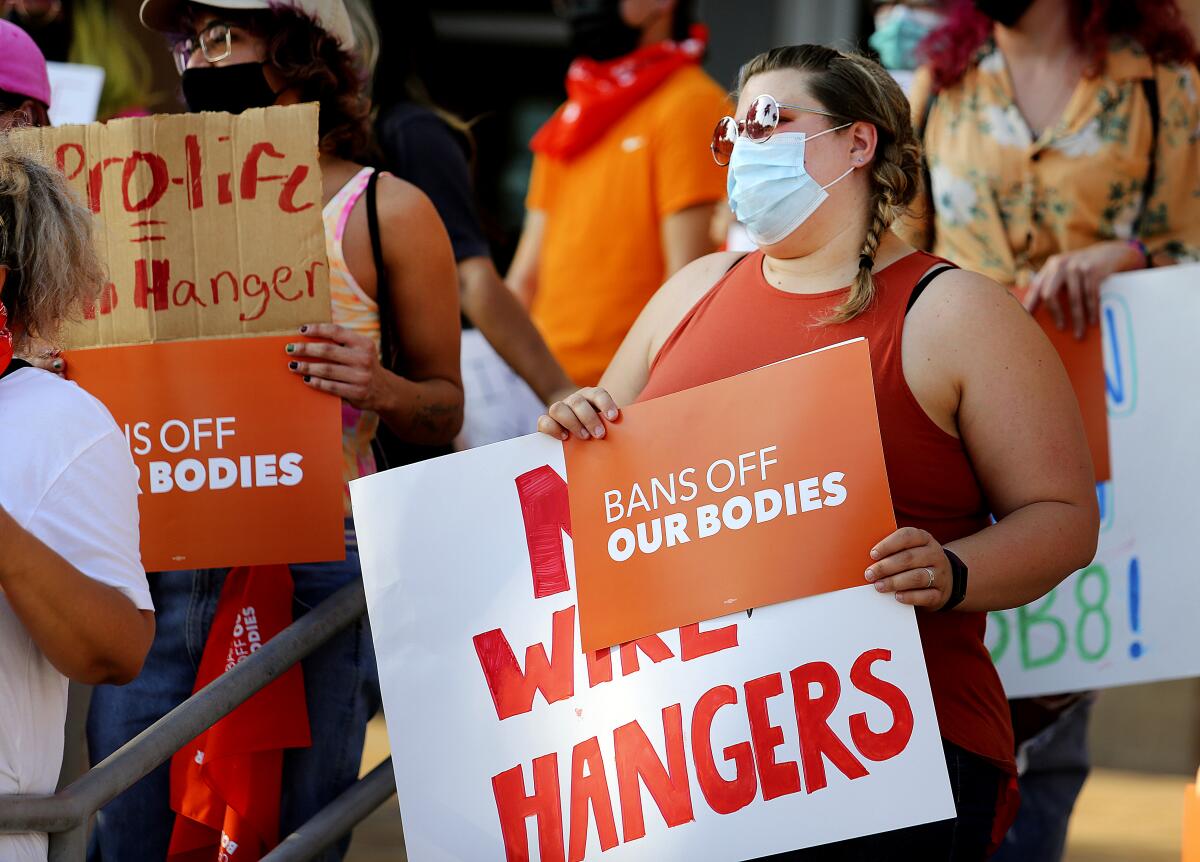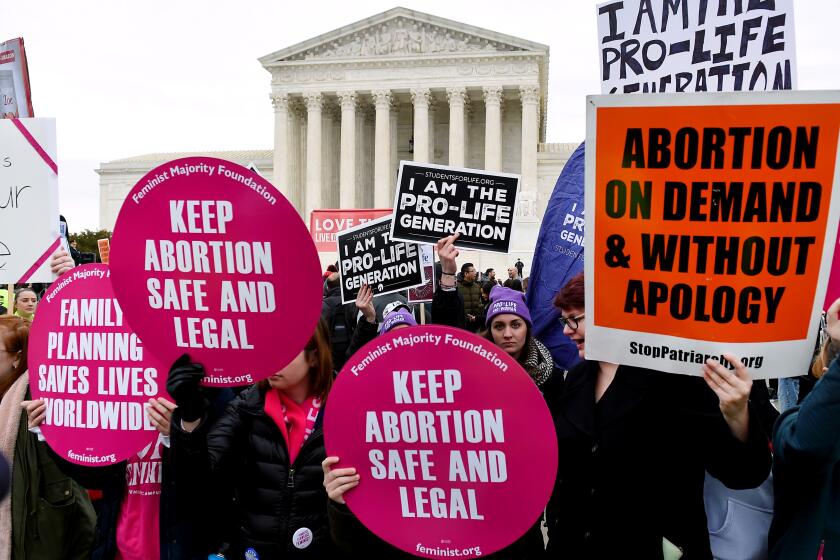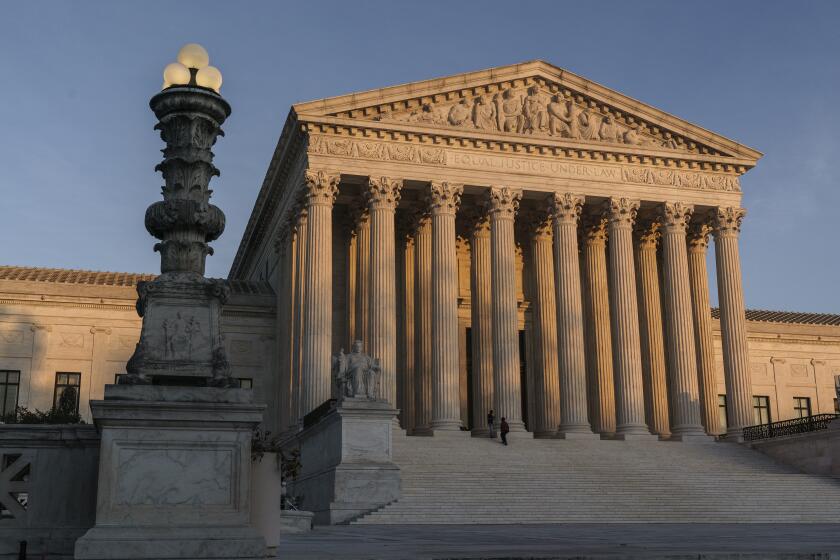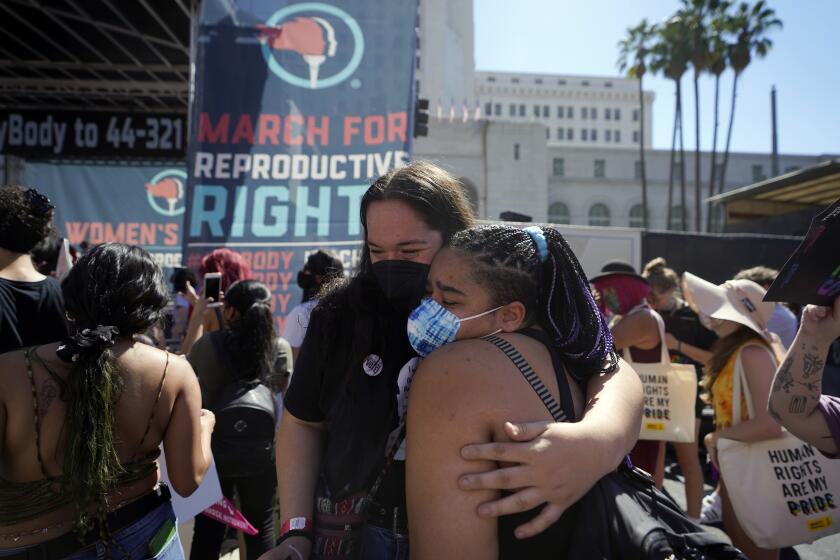Column: The wide importance of a ‘narrow’ issue in Texas’ SB 8 abortion ban

- Share via
For many observers, the case the Supreme Court heard Monday about Texas’ new abortion law is a sideshow, a “relatively narrow,” “merely procedural” footnote to the main event, Dobbs vs. Jackson Women’s Health Organization, which will be argued in December and could overturn Roe vs. Wade once and for all.
But in fact, what happened Monday is far from a footnote to Roe.
For the record:
1:45 p.m. Nov. 10, 2021This article incorrectly states that no individuals have been sued under SB 8. Two such suits have been filed.
The Texas law, known as SB 8, presents bedrock questions that go well beyond the abortion context to the very core of judicial power and constitutional rule. The justices now have an opportunity — and it seems likely they will take it up — to deliver a ringing endorsement of the ability of citizens to go to federal court to challenge state efforts to abridge their constitutional rights.
Will Trump’s appointees risk the court’s standing and establish their reputations as partisan hacks? Watch the Mississippi abortion case to find out
The focus of Monday’s hearing was the bizarre enforcement mechanism written into SB 8. The scheme, which Chief Justice John G. Roberts Jr. rightly called “unprecedented” when the court first encountered it, is the invention of antiabortion advocates who are not satisfied with trying to eviscerate Roe. They want to keep women and abortion providers from going to court to fight their clearly unconstitutional lawmaking — SB 8 bans abortion after about six weeks of pregnancy rather than the 20 or so weeks (up to viability) guaranteed by current law.
In essence, SB 8’s drafters poked a loophole into a 100-year-old Supreme Court doctrine known as Ex parte Young, based on a case involving a state attorney general named Edward Young. It provides a way to enjoin unconstitutional state statutes without running afoul of “sovereign immunity,” which generally protects states from being sued. The solution the court imposed is a balancing act: Challengers can stop state officials, rather than the state itself, from enforcing a suspect law, until the constitutional questions are resolved.
SB 8 diabolically upends Ex parte Young. It specifically prohibits state officials from having anything to do with enforcing the statute. Instead, private citizens bring suit (and potentially collect a $10,000 bounty) against anyone they believe has obtained or provided an abortion after the prescribed limit.
If Texas is right, there would be almost no limit on the power of states to violate the U.S. Constitution.
In other words, SB 8 is designed so that there’s no entity to enjoin, no way to freeze the law and force it into judicial review. It’s true that if a woman (or a clinic) is sued under the statute, she could defend herself with a constitutional argument, and the law could be challenged that way. But no such suit has been filed, and the threat of the $10,000 bounty combined with the short window of time to seek an abortion has all but closed down the procedure in the state.
As long as SB 8 is in force, Texas’ antiabortion zealots can thumb their noses at the Supreme Court and Roe, the law of the land: neener neener.
Monday’s hearing was the court’s second swing at SB 8. It declined to stay it in September, all but throwing up its hands at the novelty of the no-one-to-enjoin scheme. But this week, at least two of the previously flummoxed justices — Amy Coney Barrett and Brett M. Kavanaugh — seem to have remembered that they are members of the Supreme Court of the United States, charged with the ultimate responsibility to say what the law is and to vindicate citizens’ constitutional rights. Barrett and Kavanaugh, whose recognition of a constitutional right to abortion is likely grudging at best, were having none of Texas’ rationales.
As some states continue to outlaw abortion, places like California will have to pick up the slack.
As Kavanaugh put it during the oral arguments: “So the question becomes, should we extend the principle of Ex parte Young to, in essence, close [the Texas] loophole? … The whole sweep of Ex parte Young” — its aim to provide a way to challenge unconstitutional state laws — “would suggest extending the principle here, arguably.”
Exactly right.
The conservative justices appointed by President Trump have begun to drive the court dangerously to the right, to the point where a majority can enforce views that are grossly out of step with those of the legal profession and most citizens. That’s bad for the court and for the country.
But the tenor of the questioning on Monday was reassuring, at least with respect to principles that transcend red-blue politics. It seems very possible that Roberts, the three liberal justices, and Kavanaugh and Barrett will do what Ex parte Young did in 1908 — create doctrine that supports what is foundational to our system: Federal law is supreme and the courts are available to review and enjoin unconstitutional laws.
Indeed, such an outcome is so obviously the correct response to Texas’ neener neener that it’s hard to see on what basis the three most conservative justices — Neil M. Gorsuch, Clarence Thomas and Samuel A. Alito Jr. — might dissent.
Whatever the final tally, the opinion, instead of a sideshow or a footnote, will be one for the books.
More to Read
A cure for the common opinion
Get thought-provoking perspectives with our weekly newsletter.
You may occasionally receive promotional content from the Los Angeles Times.














